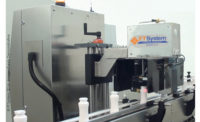Beverage packaging trends impact labeling equipment
Custom labels, unique packages require flexible, efficient machinery




An increasing number of SKUs, changing packaging formats and sizes, and a growing interest in personalization are driving a constant need for faster production. Labeling equipment is one area that has felt the pressure from these trends, and the industry continues to innovate to provide beverage manufacturers with the fastest, most flexible machinery, experts say.
Recently, beverage brands are embracing the idea of personalization on packaging. For example, in May, Atlanta-based The Coca-Cola Co. expanded on its Share a Coke campaign, which featured labels with common names, with its Share a Song campaign, which includes Coca-Cola labels featuring song lyrics. Additionally, the company’s Diet Coke brand launched the It’s Mine campaign, featuring 12-ounce contour glass bottles with full-body shrink-sleeve labels decorated in myriad designs.
Plano, Texas-based Dr Pepper Snapple Group has embraced personalization as well when its Dr Pepper brand launched the Pick Your Pepper campaign this summer. The Pick Your Pepper custom-label bottles leverage unique digital technology in which text, graphics and images can be changed from one printed piece to the next in mass quantity, the company says.
As these types of campaigns continue to prove effective and grow in popularity, labeling equipment has had to accommodate. “Recent trends indicate that it is no longer enough for producers to simply deliver a quality product in a package with a label; consumers today prefer beverages that reflect their individual needs and preferences,” says Michele Morrone, a member of Norcross, Ga.-based Sidel’s Labelling Product Management Team. “That is because key contributors to success over the past year or so have been personalization and products that match the consumer’s lifestyle. Understanding how to build end-user engagement, producers today need to be fast, flexible and willing to challenge convention.”
He adds: “The popularity of beverage label personalization is increasing significantly, with smaller batch sizes and tighter timing being natural consequences of this trend. This means a challenge for the labeling process in terms of flexibility as customized labels must be designed and produced quickly.”
Bill Hernandez, sales director for packaging at Karlville, Miami, notes that digital printing has been one major trend impacting beverage labels; however, it does not impact the labeling machinery. “The digital print technology has majorly impacted the flexible packaging machinery, but not as much the labeling equipment,” he explains. “For the change to shrink-sleeve application machinery to work smoothly on this kind of printing, it is recommended to use reverse-printing on the label in order to create less friction when the label is sliding through the mandrel.
“The benefits of the digital printing are less time obtaining the material, less scrap ratio, and the possibility for brands to personalize the label faster and use less amounts of material,” Hernandez continues. “Other types of printing in the shrink-sleeve industry usually are offset, flexo [and] gravure.”
Sidel’s Morrone notes that the market for shrink-sleeve labeling (SSL) is growing. “SSL offers the potential to reinforce branding and to create eye-catching designs to appeal to the consumer and make the product stand out from the competition,” he explains. “It can combine great flexibility and labeling quality and, in addition, presents the possibility of using all film material types. … The label sleeve can also serve effectively as a seal and, in the case of sensitive beverages, it can be used as a light-barrier.”
Because the sleeve is heat-shrunk, it eliminates container shape restrictions, and removes glue and solvents, making it easier for the PET raw material to be recycled, he adds.
Although SSL is growing in popularity, roll-fed, self-adhesive and pressure-sensitive labeling methods also are common and effective, according to Morrone.
Customization is a trend that shows no signs of slowing down, he adds. “Inventing ways in which the consumer experience can be made more personal is a current tend within packaging, which is set to continue,” Morrone explains. “The introduction of ‘iprinting,’ which allows printing directly onto the bottle, is adding even greater possibilities for personalization.”
Unique, customized packaging shapes and sizes also are impacting labeling equipment, says Justin Slarks, director of marketing for Sleeve Seal, Little Rock, Ark. “Sleeve Seal has been busy keeping up with the needs of manufacturers that are labeling unique bottles and shapes at speed,” he says. “We have machines running at 720-plus [bottles per minute] (BPM) on bottles that require orientation and have tight tolerances on label placement. The trend seems to be stylized packaging that creates a unique look on the store shelves.”
However they’re applied, labels have become more important than ever, Morrone says. “[A] label can attract the consumer’s attention and encourage them to select one beverage over another,” he says. “So, it’s even more important for a brand to stand out on the supermarket shelf. Today’s manufacturer, therefore, needs to be able to adapt and change quickly in order to react to market conditions. So, more than ever before, real flexibility within its labeling solutions is really important for any beverage producer.”
Fast and flexible
Yet, similar to many other aspects within beverage operations, a desire for higher production rates and flexibility is not new. As SKUs continue to proliferate, there’s a higher necessity to increase production time in order to quickly and efficiently accommodate product changeover.
“We see a trend toward increased machine uptime and efficiency requirements as being paramount to our customers,” says Neal Konstantin, president of PDC International, Norwalk, Conn. “Flexibility is only second to efficiency. Machines need wide capability ranges and quick, tool-less changeovers from one format to the next.”
He notes that a beverage manufacturer should look for equipment with robust design, which can allow for 24/7 uptime and reliable operation.
PDC International recently launched two new pieces of labeling equipment. Its Conform Series 140F Steam Tunnel has five individually adjustable steam zones, which offer greater shrink quality and consistency while labeling 300 containers a minute, the company says. The PDC R-350 Evolution Shrink Sleeve labeler is a multi-use shrink-sleeve labeler that processes as many as 400 difficult-to-label containers a minute, it says. The system features a tool-less changeover feature and is ideal for thin films, it adds.
Sleeve Seal’s Slarks also notes the importance that changeover flexibility has to co-packaging companies. “Flexibility is extremely important,” he says. “Co-packers want robust machines that allow for format changes at affordable prices. Machines that allow simple changeover without retraining operators are invaluable.”
According to Slarks, the company offers durable, highly efficient machines that can precisely label using affordable change parts. “Our user interface is user-friendly, and we offer on-board reference libraries and tutorials,” he says.
Changeovers are one aspect of the operation in which experts note flexibility is most essential. “It is highly important when it comes to changeovers [that] the operator can change in the least amount of time from one product production to another with different specifications,” Karlville’s Hernandez explains. “As machinery providers, we need to make sure the changeovers are friendly enough for our customers, like [when] changing a production from a 6-ounce bottle to a 32-ounce bottle in less than 20 minutes. This change in production includes changing recipient, label, [the] type of label application, machine parts and tunnel heat set-up, among other changes. In order for these changeovers to be [done] in the least amount of time, the company should have specific set-up sheets and proper training.
“The automation definitively is important for efficiencies in the complete product line,” he continues. “In labeling machinery, in order to support the productivity of the labeling line, we work [on] implementing automation as much as possible [with] regards to changeovers. Not only changeovers made from size-to-size of the containers, but also changeovers from roll-to-roll.”
Karlville offers many labeling equipment solutions, Hernandez says. “In our environment inside Karlville, for the shrink-sleeve lines we are building and supplying machines that run up to 800 [containers] per minute,” he says. “We offer standard tunnels and dry steam tunnels, which is new technology, together with the Tornado and other tunnels. We also keep up with technology on thinner materials [of] up to 25-macron with materials PVC, PET and OPS.”
Sleeve Seal’s Slarks also notes the effects that the proliferation and innovation in automation has had on labeling equipment. “As automation reaches new speeds, the labeling machines need to keep up with the other machines in the line. Line speeds are only as fast as the slowest piece of equipment, so as other machines gain speed, labelers have to keep up.”
Sidel’s Morrone explains that to keep up with the pace of automation, main mechanical parts involved in labeling machines increasingly are being replaced with servo-motors. “This is a huge impact,” he says. “The management and synchronization of all the functions becomes much more sophisticated. The information control of the process parameters for setting, maintenance and trouble-shooting is much more accurate. It reduces the need for manual intervention as adjustments can be made via the human machine interface. This also reduces maintenance and lubrication requirements.”
According to Morrone, Sidel offers solutions for many different types of labels, including shrink-sleeves, roll-fed, pressure sensitive or pre-cut.
Looking ahead, experts agree that thinner labeling materials are in store. “The speeds of other related equipment seemed to have plateaued, so the next step is a change in materials,” Slarks says. “Plus, thinner materials offer fewer changeovers, more cost-effective shipping and lower costs per impression.”
Karlville’s Hernandez echoes similar sentiments. “The future for the shrink-sleeve equipment is to continue improving the application of thinner materials to lower the cost of the label, to continue to make the machinery smaller and more compact and to continue improving speeds,” he says.
Looking for a reprint of this article?
From high-res PDFs to custom plaques, order your copy today!









